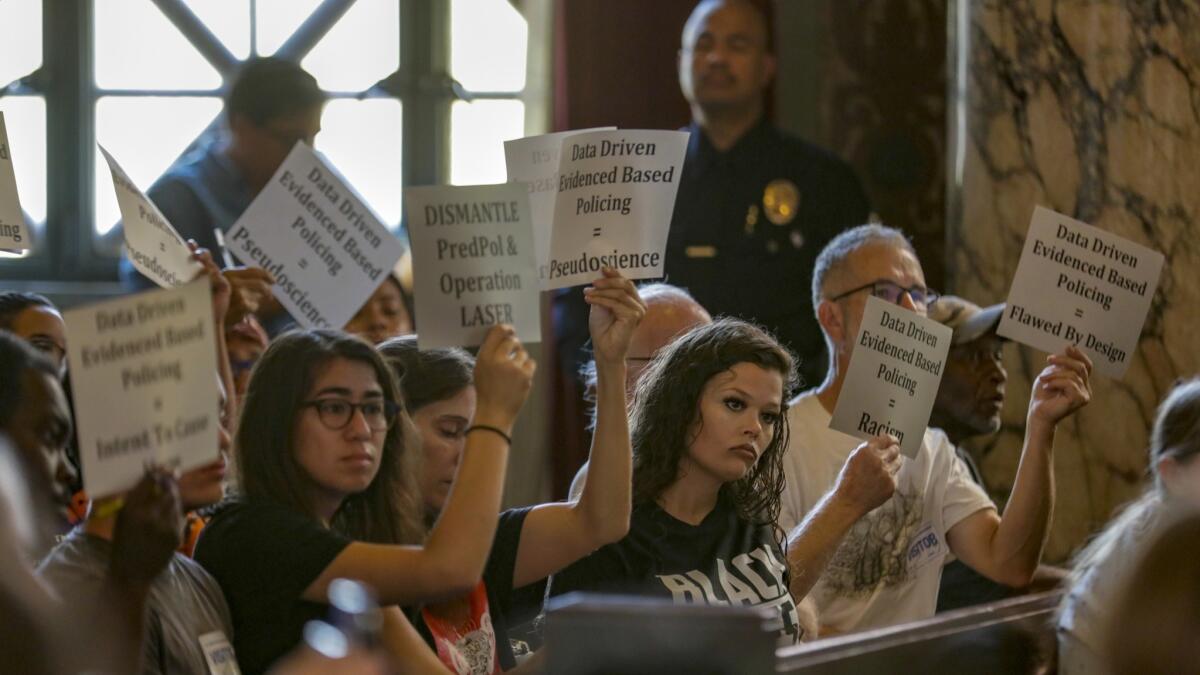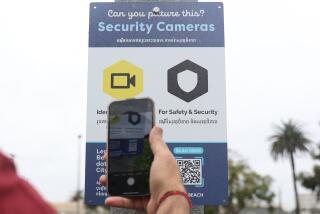LAPD officials defend predictive policing as activists call for its end

Early each morning, computers spit out maps of Los Angeles, marked with red squares where a complex algorithm has judged that property crimes are most likely to occur.
As police officers patrol the streets, they keep these areas in mind, perhaps taking a detour to pass through on the way to a call, or warning people not to leave valuables in their cars.
But so-called predictive policing and other ways that the Los Angeles Police Department uses data to fight crime are sounding alarm bells for civil liberty and privacy groups, who engaged in a heated debate with department brass at a Police Commission meeting Tuesday.
The activists lambasted the methods, which identify crime hotspots as well as “chronic offenders” who are likely to commit crimes, as biased against blacks and Latinos, with some calling for them to be abolished.
The crime statistics that fuel the computer models could be skewed by racial bias, with the result that more policing is concentrated on blacks and Latinos, many said.
“Data is a weapon and will always be used to criminalize black, brown and poor people,” said Jamie Garcia of the Stop LAPD Spying Coalition, which released a report in May critiquing the department’s data policing techniques.
Members of the coalition held signs with messages such as “Crime Data is Racist” and “Data Driven Evidence Based Policing: Pseudoscience.”
From the “Compstat” crime analysis meetings started by former Police Chief William J. Bratton to the adoption of predictive policing for property crimes in 2015, the LAPD has been at the forefront of using data to refine its crime-fighting tactics. Station captains are still grilled by higher-ups at weekly Compstat meetings about how to reduce crime, and crime statistics for each station are updated online every few weeks.
For violent crime, the department draws “LASER” — “Los Angeles’ Strategic Extraction and Restoration” zones — devised by a human crime analyst, not a computer — indicating where many crimes have occurred and therefore where more police officers should go.
Perhaps the most controversial LAPD program targets people rather than geography, using a matrix of factors, including gang membership and violent crime arrests, to identify “chronic offenders” who will receive extra police scrutiny.
In 2016, after a spike in violent crime in South Los Angeles, the department set up a numbers-crunching center to collect crime data from the previous 24 hours and review it with command staff each morning. The approach continues to be used and has expanded to other areas of the city.
“We’re trying to get better about where to put scarce police resources to prevent crime from happening in the first place,” Deputy Chief Sean Malinowski said at the meeting.
Police Commissioner Cynthia McClain-Hill said she was particularly concerned about programs like those targeting chronic offenders that are “people-based as opposed to place-based.”
She asked the department’s inspector general to review the costs and benefits of data-based policing.
“Any cost in terms of public trust is something we should take very seriously,” she said.
Police Chief Michel Moore, who was sworn in last month after serving as the LAPD’s second-in-command, said he supports an inspector general review. He acknowledged that the data used in the models are imperfect and that the department must convince residents that it is being put to good use.
Moore, who is considered by LAPD insiders to be second to none in his mastery of crime statistics, said the goal is not making more arrests but helping the people and neighborhoods targeted by predictive policing and other data-intensive methods.
“Identifying communities in need of intervention and prevention is what we’re trying to do,” Moore said.
Deputy Chief Dennis Kato, who oversees South Bureau, gave examples of how that has been done in recent years.
In South Park, after a spate of armed robberies, police officers spent time at a senior center in the area, causing the culprits to go elsewhere and strengthening the officers’ relationships with the elderly residents, Kato said.
At Rosecrans and Vermont avenues in the Harbor Gateway area, where aggravated assaults were high, officers found that school buses were dropping off students from different gangs at the same time. They solved the problem by staggering the arrival of the buses.
Focusing on “chronic offenders” has a benefit, too, allowing police to concentrate on those people while cutting back on random stops of innocent drivers, Kato said.
“We always knew who the bad guys were,” Kato said. “We’re making sure we don’t stop others in the community if we can figure out who those violent people are.”
But many speakers at the meeting said the programs were riddled with racial bias, and the only solution was to dismantle them.
“Predictive policing is nothing but a Stasi, Nazi Germany style for targeting people of color,” Yasmin Adan, an immigrant from Somalia in her 40s, said.
Alexis Takahashi, 26, a program manager for a nonprofit, was more measured in her criticism.
Methods developed by the LAPD “under the guise of science” end up magnifying racial bias, she said. She expressed concern that people identified by the data as criminals are more likely to be approached by the police, possibly leading to a violent encounter.
“I support an audit by the inspector general and a public dialogue to see whether we’re helping those communities or causing more harm,” Takahashi said.
For more news on the Los Angeles Police Department, follow me on Twitter: @cindychangLA
More to Read
Sign up for Essential California
The most important California stories and recommendations in your inbox every morning.
You may occasionally receive promotional content from the Los Angeles Times.











